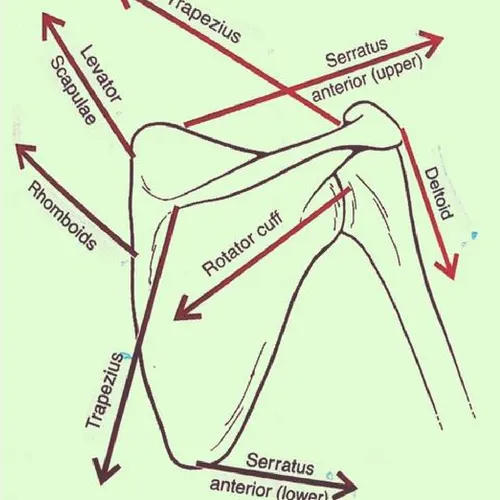Swimmer’s or Surfer’s Shoulder is a common condition affecting both competitive and recreational swimmers and surfers. It is basically an overuse injury which results in shoulder impingement or rotator cuff type symptoms.
How Surfer’s or Swimmer’s Shoulder Develops
The action of paddling in surfing strengthens the larger muscles around the shoulder, some of the major ones taxed being the pec major, pec minor, deltoids, upper trapezius, levator scapulae, lats and serratus posterior. These muscles when strong relative to their opposite acting muscles tend to apply upward force on the arm bone, migrating it north toward the bone above. The rotator cuff muscles when strong will apply a downward force on the ball of the arm bone.
Because of regular paddling we tend to become strong in the muscles that apply this upward force and relatively weak in the rotator cuff muscles that apply downward force. This can result in the ball of the arm bone sliding upwards in the shoulder joint.
Muscular imbalance is a key problem, but also so can be restricted mobility in the thoracic spine, neck, hips and shoulders. Paddling places a massive amount of stress on the rotator cuff in general, they need to work their derrière’s off to keep up with the stronger muscles that surround them. The freestyle and paddling strokes result in overdevelopment of both the shoulders internal rotators (subscapularis), compared to external rotators (infraspinatus) and the anterior chest wall musculature (pectoralis major and minor) relative to the posterior wall scapular stabilisers (rhomboids, levator scapuli, serratus anterior and middle/lower trapezius).
Shoulder Impingement Syndrome
Impingement Syndrome occurs when there is abnormal contact between the rotator cuff muscles and the roof of the shoulder (acromion). Normally, a sac of tissue (bursa) sits on top of the rotator cuff, allowing the muscles to glide smoothly as the shoulder moves in different directions. When the arm is raised, the space between the rotator cuff and acromion becomes smaller. There is usually enough room in the shoulder joint for this to occur without pain. With repeated paddling, irritation and damage to the rotator cuff can occur and the bursa can swell. This decreases the space in the shoulder and compresses the rotator cuff muscles, causing pain.
Internal Impingement
A subtype of impingement is called internal impingement. This occurs as a result of imbalanced forces in the shoulder capsule, which is a fibrous tissue. In some people, the front part of the capsule is too loose, or unstable, and the back part is way too tight. This results in an imbalance of forces across the joint, especially with overhead stuff like paddling. Abnormal contact between the rotator cuff muscles and the back part of the capsule occurs, damaging the rotator cuff, capsule, and labrum and ultimately causing pain.
If this impingement is allowed to go on for an extended period of time it can cause small tears in the rotator cuff tendons, reduce blood supply and important nutrition to the shoulder joint.
Rotator cuff injury is a continuum beginning with impingement and progressing to a cuff tear. The cuff tendons have areas of low blood supply, making healing more difficult after injury. As a result, the tendons degenerate with time. This is why most tears occur in late middle age.

Impact of Surfing on Shoulder and Body Alignment
Surfers often experience tight hip flexors due to the sport’s demands. The repetitive motion of rotating the hip towards the back foot can lead to imbalanced loading across the spine, hips, knees, and ankles over time. These imbalances generate tension, compromising core stability, which significantly impacts surfing performance and overall bodily function. Additionally, prolonged muscle-shortening exacerbates stress on the dominant shoulder, particularly for natural footed surfers, disrupting alignment and reducing flexibility, coordination, and strength. Right-handed individuals may further experience muscle imbalances, with the right hip elevating as the right shoulder depresses, resulting in chronic stress affecting various joints. This imbalance also shortens the neck, chest, and internal rotator muscles of the shoulders, restricting their range of motion. Understanding these impacts is crucial for surfers seeking to optimise their performance and prevent injury.
Diagnosis of Surfer’s or Swimmer’s Shoulder
Surfer’s or Swimmer’s Shoulder is typically characterised by discomfort experienced at the front or back of the shoulder, particularly noticeable during or after surfing, especially when engaging in paddling motions. Common physical indicators include rounded shoulders and subtle winging of the shoulder blades. Additionally, individuals may experience pain when lifting the arm directly upwards or outwards from the side. Another prevalent symptom is shoulder instability, which can further contribute to the overall discomfort and functional limitations associated with this condition. If you’re experiencing these symptoms, it’s essential to seek proper diagnosis and treatment to address the underlying issues effectively.
